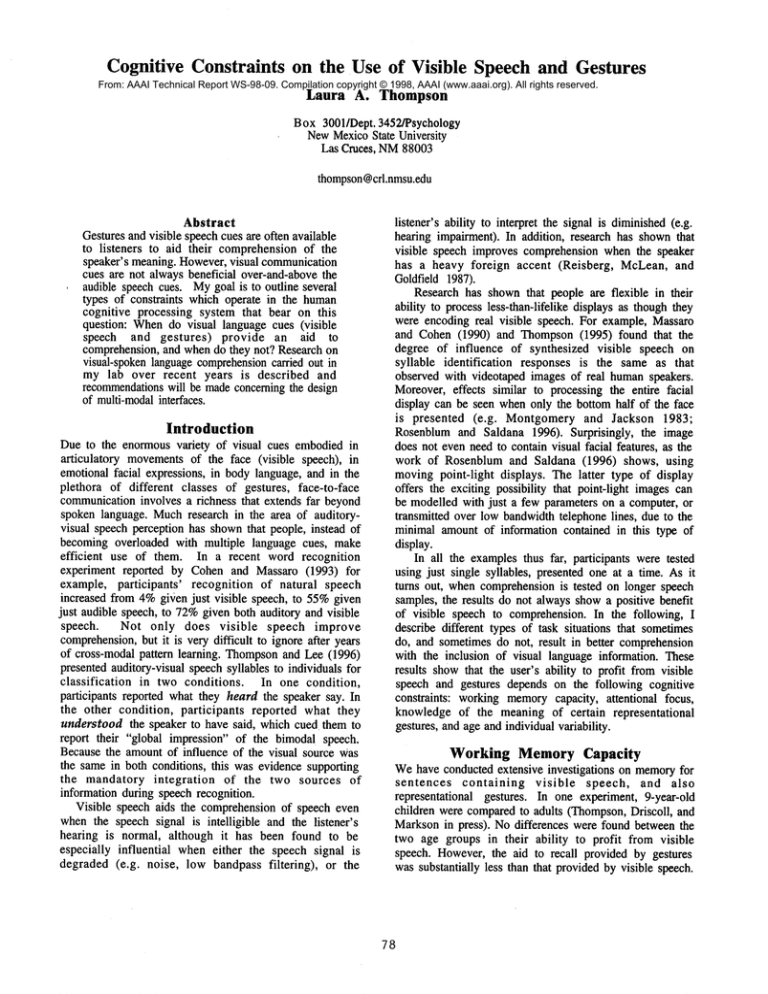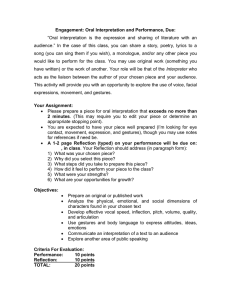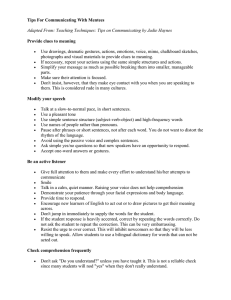
Cognitive Constraints on the Use of Visible Speech and Gestures
From: AAAI Technical Report WS-98-09. Compilation copyright © 1998, AAAI (www.aaai.org). All rights reserved.
Laura
A.
Thompson
Box 30011Dept. 3452/Psychology
NewMexicoState University
Las Cruces, NM88003
thompson@crl.nmsu.edu
Abstract
Gesturesand visible speechcues are often available
to listeners to aid their comprehension of the
speaker’s meaning. However,visual communication
cues are not always beneficial over-and-abovethe
audible speech cues. Mygoal is to outline several
types of constraints which operate in the human
cognitive processing system that bear on this
question: Whendo visual language cues (visible
speech and gestures)
provide an aid to
comprehension, and whendo they not? Research on
visual-spoken languagecomprehension
carried out in
my lab over recent years is described and
recommendations
will be madeconcerning the design
of multi-modalinterfaces.
listener’s ability to interpret the signal is diminished(e.g.
hearing impairment). In addition, research has shownthat
visible speech improves comprehension when the speaker
has a heavy foreign accent (Reisberg, McLean, and
Goldfield 1987).
Research has shownthat people are flexible in their
ability to process less-than-lifelike displays as thoughthey
were encoding real visible speech. For example, Massaro
and Cohen (1990) and Thompson(1995) found that
degree of influence of synthesized visible speech on
syllable identification responses is the same as that
observed with videotaped images of real humanspeakers.
Moreover,effects similar to processing the entire facial
display can be seen whenonly the bottom half of the face
is presented (e.g. Montgomery and Jackson 1983;
Rosenblum and Saldana 1996). Surprisingly, the image
does not even need to contain visual facial features, as the
work of Rosenblum and Saldana (1996) shows, using
movingpoint-light displays. The latter type of display
offers the exciting possibility that point-light imagescan
be modelled with just a few parameters on a computer, or
transmitted over low bandwidthtelephone lines, due to the
minimal amount of information contained in this type of
display.
In all the examplesthus far, participants were tested
using just single syllables, presented one at a time. As it
turns out, whencomprehensionis tested on longer speech
samples, the results do not always showa positive benefit
of visible speech to comprehension. In the following, I
describe different types of task situations that sometimes
do, and sometimesdo not, result in better comprehension
with the inclusion of visual language information. These
results showthat the user’s ability to profit from visible
speech and gestures depends on the following cognitive
constraints: working memorycapacity, attentional focus,
knowledge of the meaning of certain representational
gestures, and age and individual variability.
Introduction
Due to the enormous variety of visual cues embodied in
articulatory movementsof the face (visible speech),
emotional facial expressions, in body language, and in the
plethora of different classes of gestures, face-to-face
communicationinvolves a richness that extends far beyond
spoken language. Muchresearch in the area of auditoryvisual speech perception has shownthat people, instead of
becoming overloaded with multiple language cues, make
efficient use of them. In a recent word recognition
experiment reported by Cohen and Massaro (1993) for
example, participants’
recognition of natural speech
increased from 4%given just visible speech, to 55%given
just audible speech, to 72%given both auditory and visible
speech. Not only does visible
speech improve
comprehension,but it is very difficult to ignore after years
of cross-modal pattern learning. Thompsonand Lee (1996)
presented auditory-visual speechsyllables to individuals for
classification
in two conditions. In one condition,
participants reported what they heard the speaker say. In
the other condition, participants reported what they
understood the speaker to have said, which cued them to
report their "global impression" of the bimodal speech.
Because the amountof influence of the visual source Was
the same in both conditions, this was evidence supporting
the mandatory integration
of the two sources of
information during speech recognition.
Visible speech aids the comprehensionof speech even
whenthe speech signal is intelligible and the listener’s
hearing is normal, although it has been found to be
especially influential when either the speech signal is
degraded (e.g. noise, low bandpass filtering),
or the
Working
Memory Capacity
Wehave conducted extensive investigations on memoryfor
sentences containing
visible
speech, and also
representational gestures. In one experiment, 9-year-old
children were comparedto adults (Thompson,Driscoll, and
Marksonin press). No differences were found between the
two age groups in their ability to profit from visible
speech. However,the aid to recall provided by gestures
was substantially less than that provided by visible speech.
78
Interestingly,
due partly to working memorycapacity
limitations, older adults’ comprehensionof language was
not aided by the inclusion of representational gestures,
while younger adults’ comprehension was influenced by
gestures
(Thompson 1995; Thompson and Guzman
forthcoming).
Whenauditory-visual speech is clearly presented without
any extraneous demands on processing, older adults are
particularly dependenton visible speech cues, even moreso
than young adults (Thompson1995). However, when the
attention demandsof the listening task are considerable,
older adults are unable to encodethe visible speech cues and
gestures (Thompson and Guzmanforthcoming). Thus,
visual information may not be encoded when working
memory
is taxed to its functional limits.
Attentional
Focus
Another cognitive factor which could determine the extent
of influence of visible speech is the listener’s spatial
attentional focus on the speaker’s face. Wehave conducted
a preliminarystudy to discover the spatial characteristics of
attention distribution across the speaker’s face (Thompson,
Goodell, and Boring forthcoming).
Videotaped
reenactments of speeches by two famous public speakers
were used as materials. The speeches were divided into
segments. At the end of each segment, a pattern of dots
appearedin one, two, or three of four positions on the face
for either 16 or 33 milliseconds. The positions were in the
center of the forehead directly abovethe eyes, on top of the
left ear, on top of the right ear, and directly below the
mouth. Oneof the participants’ tasks was to record, onto
caricatured faces on paper, the dots they had seen in the
immediately preceding videotaped segment. To help ensure
that participants concentrated on the content of the
speaker’s discourse, participants also had to complete a
comprehensiontask related to the immediately preceding
speech segment. The results were dramatic: comparedto
young adults, older adults’ attentional focus was on the
mouth,at the expenseof attending to the other areas of the
face, while younger adults did not show differential
attentional focus to the various regions of the face.
Knowledge
of Gesture
Meaning
In a recent experiment, we found that representational
gestures, gestures representing actions and attributes of
objects or characters, contributed directly to the meaningof
utterances (Thompson,Driscoll, and Markson in press).
This is a controversial issue because the limited numberof
reported studies on the topic has yielded contradictory
results. Wecompared memoryfor phrases (noun phrases
versus predicate term phrases) containing a representational
gesture to the same type of phrases which did not contain
gestures. Adults’ memoryfor the words in both noun and
predicate term phrases was better when the words were
accompaniedby gestures. Nine-year-old children’s memory
was better whengestures appearedwith predicate terms, but
not when gestures accompanied nouns. Wereasoned that
the mapping between actions communicatedby predicate
79
term gestures and their verbs was more direct and easily
interpretable comparedto the mappingbetween nouns and
gestures. Children might be especially susceptible to a
processing
advantage involving
fewer steps of
interpretation. However,as they gain word knowledgeof
the meanings communicatedbehind even the most obtuse
of gestures, they stand a greater likelihood of incorporating
these gestures into their understanding of the speaker’s
meaning.
Age and Individual
Variability
Someof my research has shown a developmental trend
toward greater influence of gesture and visible speech
information across childhood (e.g., Thompsonand Massaro
1994). As children get older, they seem better able to
incorporate the multiple cues to meaning which are
available for themto use.
Wehave found wide variability between adults in the
amountof influence of visible speech in auditory-visual
speech perception. In one experiment, participants watched
a videotape of a speaker clearly articulating one of two
syllables, /ba/or/da/(Thompson 1995). Their task in one
condition was to discriminate the two visible speech tokens
(to lipread). In the other condition, synthesized speech
tokens ranging along a five-step speech continuumgoing
from a clear/ba/to a clear Ida/were dubbed onto the two
visible speech tokens, and their task was to report what
they "understood". In two adult age groups, lipreading
ability in the visible-speech
alone condition was
significantly correlated with the extent of influence of
visible speech in the auditory-visual condition. Further,
two groups of participants emerged: those that were
"visually-oriented" and those that were "auditoriallyoriented" whenthe cues were ambiguous.
Implications
Most research conducted on humanparticipants supports
the general recommendationthat computer systems which
present speech to the user should conjointly present visible
speech (Thompsonand Ogden 1995). However, the narrow
set of experimental conditions used to support this
recommendation must be acknowledged. First, the task
demandsplaced minimal cognitive processing requirements
on the individuals being tested. Second,the participants in
the experiments were usually youngadults whoare at their
prime, cognitively speaking. Third, individual differences
were ignored. Our research demonstrates the importance of
taking into consideration manycognitive constraints which
are revealed with lengthier speech samples embeddedinto
morecomplicatedtask contexts. In so doing, it is apparent
that gestures and visible speech can aid comprehension,but
only when: (a) the users’ working memorycapacity
sufficiently strong to incorporate visual language, (b) the
users’ spatial attentional focus includes the mouthregion
of the face, and (c) the user has gained a certain amount
experience interpreting the meaningspresented visually.
Beingawareof cognitive constraints in the use of visual
language can help facilitate intelligent design of multi-
modal human-computer interaction.
More specific
recommendationswill be made at the workshop.
References
Cohen, M. M., and Massaro, D. W. 1993. Modeling
coarticulation
in synthetic visual speech. In N. M.
Thalmannand D. Thalmann(Eds.), Models and techniques
in computer animation, (pp. 139-155). New York:
Springer-Verlag.
Montgomery,A. A., and Jackson, P. L. 1983. Physical
characteristics of the lips underlying vowel lipreading
performance. Journal of the Acoustical Society of America
73: 2134-2144.
Reisberg, D., McLean,J., and Goldfield, A. 1987. Easy
to hear but hard to understand: A lipreading advantage with
intact auditory stimuli. In B. Dodd and R. Campbell
(Eds.), Hearing by eye: The psychology of lipreading.
Hillsdale, NJ: Erlbaum.
Rosenblum, L. D., and Saldana, H.M. 1996. An
audiovisual test of kinematic primitives for visual speech
perception. Journal of Experimental Psychology: Human
Perception and Performance22:3 18-33 1.
Thompson, L.A. 1995. Encoding and memory for
visible speech and gestures: A comparison between young
and older adults. Psychology and Aging 10: 215-228.
Thompson,L. A., Driscoll, D., and Markson, L. in press.
Memory
for visual-spoken language in children and adults.
Journal of NonverbalBehavior.
Thompson, L. A., Goodell, N., and Boring, R. Where is
the listener s attentional focus on the speaker s face?
Forthcoming.
Thompson, L. A., and Guzman, F. 1998. Some limits
on encoding visible speech and gestures using a dichotic
shadowing task~ Forthcoming.
Thompson, L. A., and Lee, K. 1996. Information
integration in cross-modal pattern recognition: An
argument for acquired modularity. Acta Psychologica 92:
79- 104.
Thompson, L. A., and Massaro, D. W. 1994. Children’s
integration
of speech and pointing gestures in
comprehension.
Journal of Experimental
Child
Psychology 57: 327-354.
Thompson, L. A., and Ogden, W. C. 1995. Visible
speech improves human language understanding:
Implications for speech processing systems. Artificial
Intelligence Review 9: 347-358.
8O





